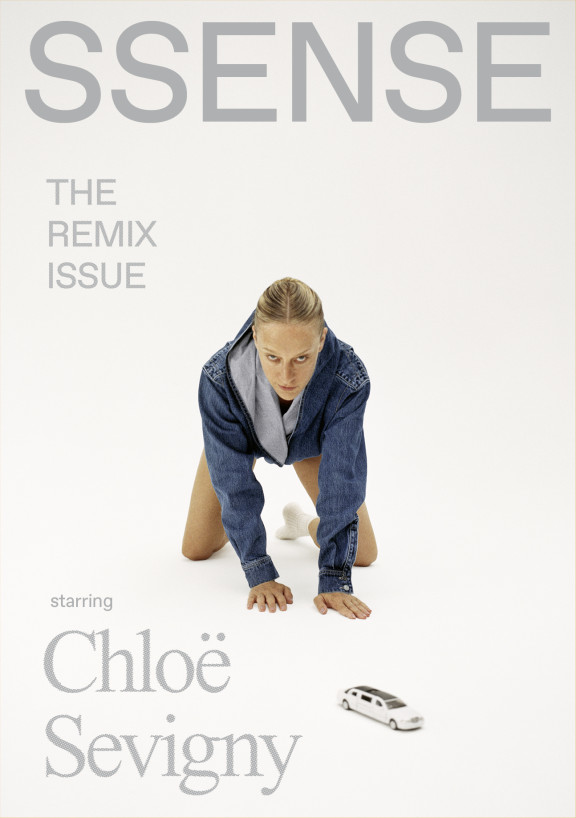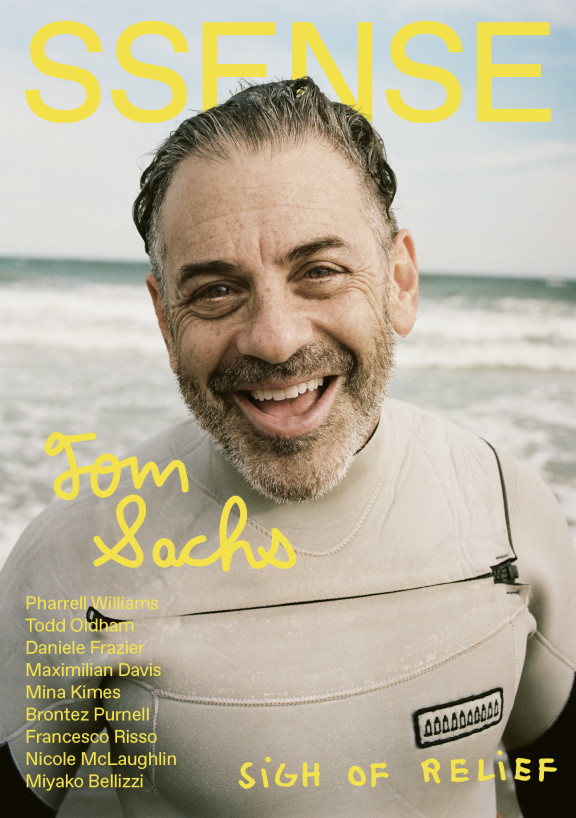Fall-Winter
2022
2022
Featuring Chloë Sevigny, Myhaʼla Herrold, Sinéad OʼDwyer, Anna Sui, Nicholas Daley, MUNA, Sam Barsky, Connor McKnight, Skiifall



Editor's Letter
The remix is inherently audacious. When Sean Combs got the call to remix Mariah Careyʼs smash single “Fantasy” he dismissed the original—a song that would sit at the very top of the charts for eight weeks. According to Puffy, theyʼd sampled the wrong part of Tom Tom Clubʼs “Genius of Love,” the sparkly synth backbone of “Fantasy.” The remix is an act of criticism: Cut this verse. Repeat this phrase. Insert this drum loop. Drop the tempo. Sample this part instead—and add a verse from Olʼ Dirty Bastard, too. Of course, that last one was Mariahʼs idea.
Lee “Scratch” Perry, the singular Jamaican recording artist and producer, one of the key figures in the history of the remix, spoke about his process in elemental ways. “My brain that I make records from is real mad. Mad in love, not in destruction. Positive madness. Love madness. All of my best records I make when I am mad with positive love. The things people are afraid of, that is what I want,” he told Spin in 1985. The suits at the label were afraid of ODB, but Mariah was sure of herself.
This is the remix issue of SSENSE. A few years in and we think weʼve gotten pretty good at making a magazine, which is why weʼve decided to try on some new things. Throw out some of our old design protocol, muss things up. Perry muddied up his tracks with found sounds, like a babyʼs cry or a cowʼs moo. Perhaps our equivalent is the hand-drawn titles from Nejc Prah in the special zine section “Made by Hand,” with stories dedicated entirely to creators who prefer the tactile approach.
A remix can create new context and blur form, and weʼve spoken with artists whose work is similarly boundary-straddling, like the molded pieces in Irish designer Sinéad OʼDwyer’s clothes that exist somewhere at the intersection of visual art and fashion. Her work falls in line with Perry’s ambition to pursue things people fear with love. OʼDwyer emphasizes size inclusivity in her designs, a reaction to fatphobia in the fashion industry. Clothing as art. Clothing as praxis. Véronique Hyland, fashion features director at ELLE, and Francesca Granata, associate professor of fashion studies at Parsons, discuss the latter explicitly in their wide-ranging discussion of fashion criticism with writer Camille Okhio. All three are well versed in the history of clothes and how we wear them—British nineteenth-century dress codes and the sumptuary laws of the sixteenth century are relevant topics of conversation.
The past merging with the present is another hallmark of the remix, as the bones of something that already exists contribute to something new. Thereʼs a happy accident in this issue: The cover star Chloë Sevigny appears twice, once in her profile and again in the fashion editorial “Hey Young World.” The second feature captures the style of some young creative families in London, and in the living room of the Kungu-Addy residence there hangs a framed one-sheet poster for Harmony Korineʼs Julien Donkey-Boy bearing the face of Sevigny circa 1999. Itʼs one of her best movies.
The writer Thora Siemsen spoke with Sevigny about many of her films and the beloved filmmakers sheʼs worked with, including Korine. Sevigny is renowned for her style and adored by the fashion industry, and her work as an actor is underrated as a result. Siemsen toggles the context to moving pictures and examines what makes Sevigny a great performer. As it turns out, it still has to do with taste. There are certain things you can’t tamper with.
Ross Scarano
Interim Managing Editor
Read Issue 7 Online
FW22 SPECIAL MADE BY HAND
Spring-Summer
2022
2022
Featuring J Balvin, Dijon, Sean Brown, Sir Paul Smith, Priya Ahluwalia, Colpa Press, Jawara Wauchope, Sean-Kierre Lyons, Colette, Amy Auscherman
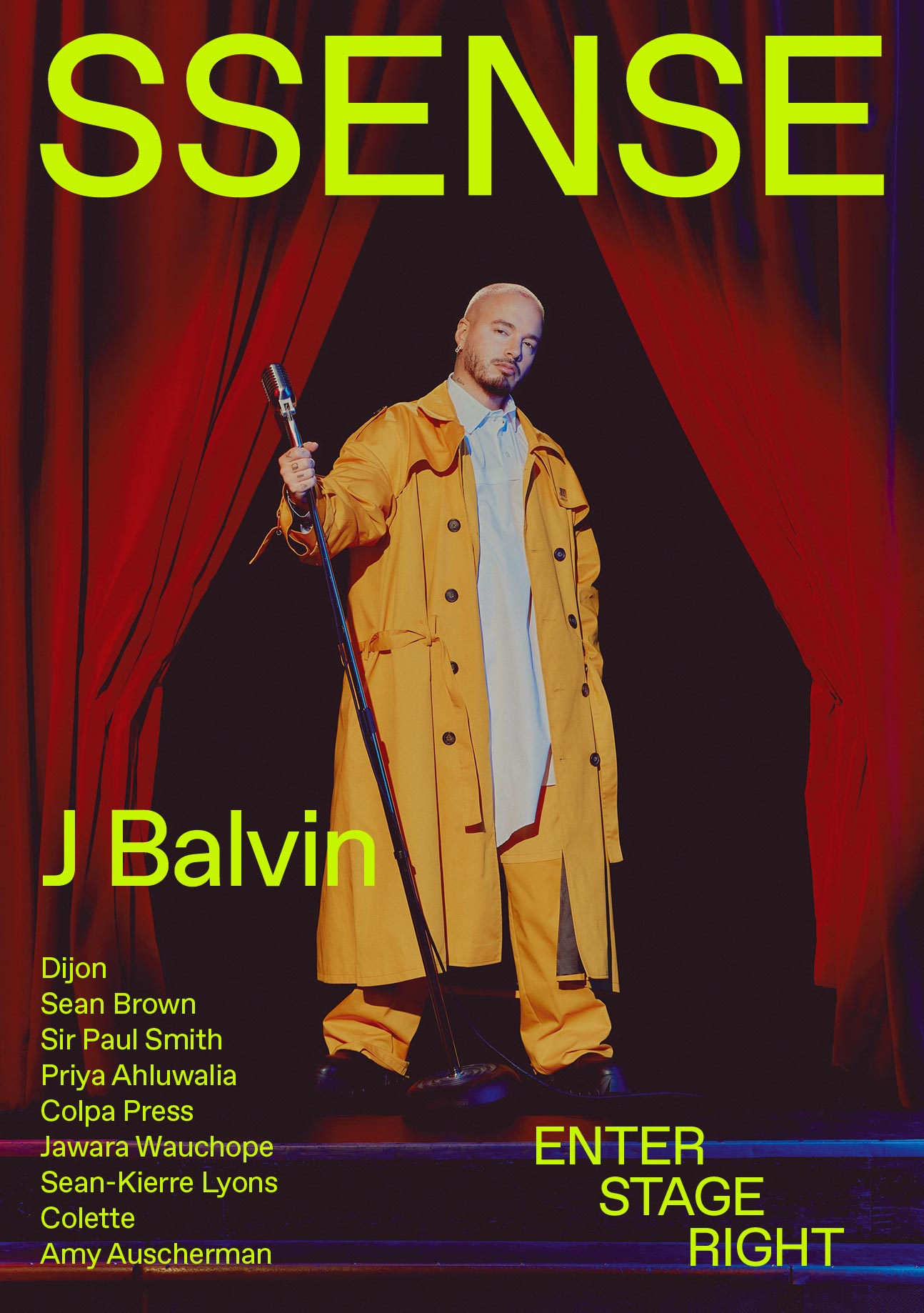


Editor's Letter
“The house image would appear to have become the topography of our intimate being,” Gaston Bachelard wrote in The Poetics of Space, the 1958 classic philosophical text about architecture.
Writer Sophie Haigney deploys the quote in her oral history of the cult magazine Apartamento to explain the allure of the homes depicted in its pages. Apartamento makes the reader feel that they’re closer to touching something real. Its candid photographs give the sensation of privileged access to a home and, therefore, a person. Haigney’s story is part of a sequence entitled “Interiors,” planned and executed by our Editor-in-Chief Durga Chew-Bose. You’ll find that zine inside this issue, with an essay by Rebecca Bengal on the memories a home can retain, and a cozy fashion editorial shot by Louis Canadas featuring the Danish textile brand Tekla and the perfect recipe for porridge. There’s an interview with Amy Auscherman, director of archives and brand heritage at American furniture company Herman Miller, who sheds light on why you may be seeing so much mid-century modern in the homes of your friends.
As your interim managing editor, I used “Interiors” as a jumping-off point for further investigations into design in its many permutations. For the cover, global pop star J Balvin was shot by Victor Llorente on location at a small, private venue in New York, all the better to capture the details of his preparation for return to life on tour. The Colombian reggaetón star is the modern pop icon turned brand exemplified: He collaborates with fine artists and designers, has his own Jordan, and cultivates an audience of millions around the world with music that samples styles widely. He’s kind of a creative director as musical dynamo—a distinctly contemporary idea.
During the creation of this issue, Virgil Abloh passed away at the age of 41. He embodied the idea of design in a singular, totalizing way—who but Abloh would have boxed up his Chicago office, from the highlighters to Post-It notes, design reference books to petty cash, and shipped it to Canada, where a precise re-creation was staged at SSENSE MONTRÉAL? He called that piece “CUTTING ROOM FLOOR,” and like everything he did, it drew quite the crowd. Abloh had connections to multiple participants in this issue, including Balvin, who was a guest performer at one of Abloh’s storied DJ sets; Oana Stănescu, organizer of the “Unmeasurables” architecture roundtable and a friend and collaborator of Abloh’s; and Jawara Wauchope, the acclaimed hairstylist who worked with Off-White. These ties are proof of Abloh’s sweeping reach across industries, and also reminders of what has been lost.
Every page has been crafted to be about design: to show how it can take you inside a home, a thought, a feeling, all to better understand how it works. To reach the interior.
There’s much more but please, step inside and see for yourself.
Ross Scarano
Interim Managing Editor
Read Issue 6 Online
Fall-Winter
2021
2021
Featuring Pharrell Williams, Tom Sachs, Daniele Frazier, Francesco Risso, Miyako Bellizzi, Nicole McLaughlin, Todd Oldham, Maximilian Davis, Mina Kimes, Brontez Purnell, Borna Sammak, Tracy Ma
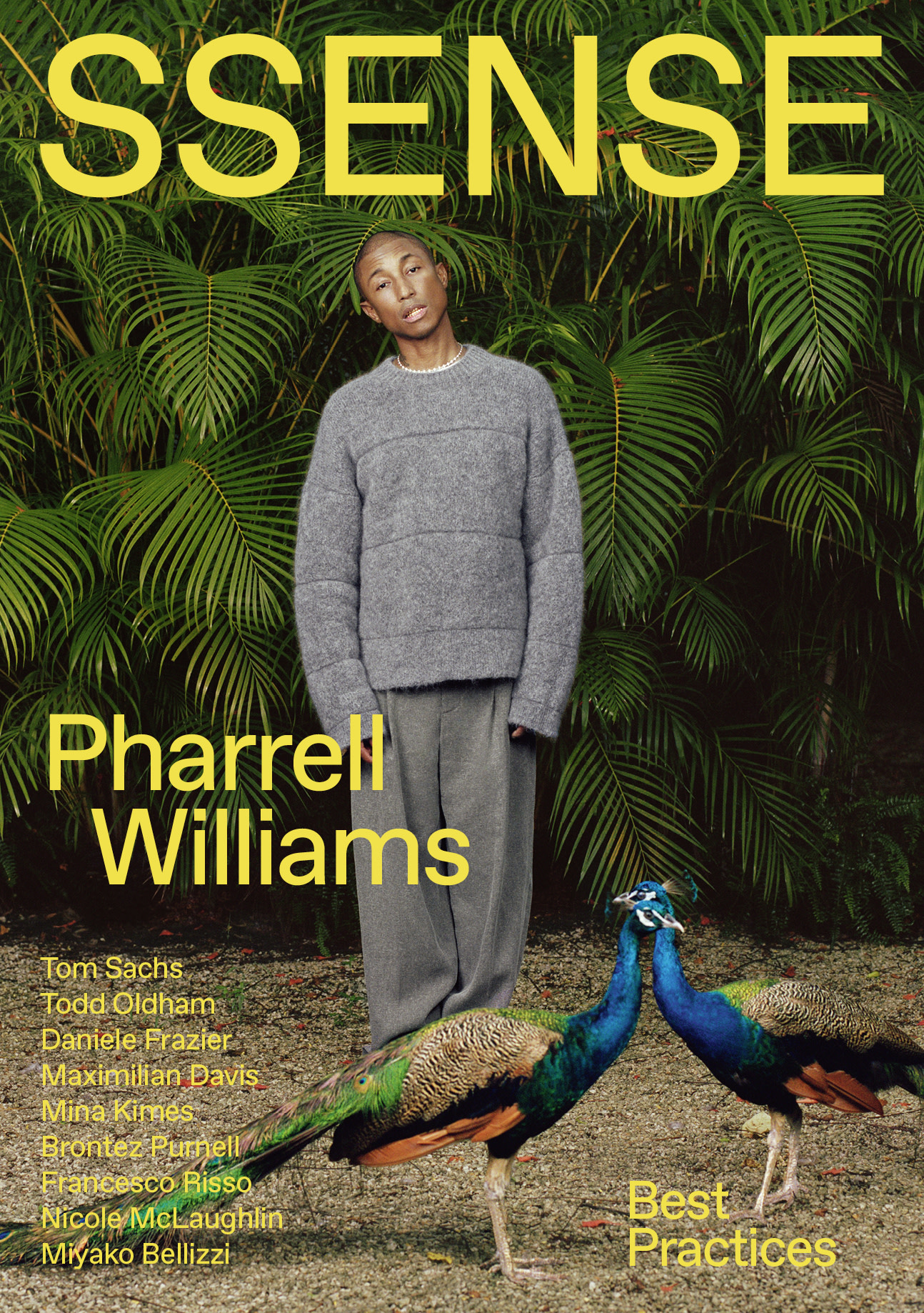

Editor's Letter
This time around, for our Fall-Winter 2021 issue, the SSENSE team set out to build a magazine that felt loose, freed from any clear path. We wanted to have fun. We wanted to register some nonsense and enjoy—on the page—long-held anticipations: moments of ease, a good howl, emotional shopping, beautiful, far out craft. In doing so, we asked ourselves and our community of collaborators: How? With whom? When was the last time? What did it feel like? Did the joke land? Describe that one party that inched close to euphoria. Tell us a story.
We considered play, in all its forms: design, dress-up, childhood, rituals for healing and taking care, joy rides, and dreaming big. Pleasure, we remembered, is not necessarily linked to value or acquisition—it can be a feeling that meets you where you are, if you let it. Look up at the sky. Revisit your closet. Make a movie with your friends. Stay in bed.
Pleasure, like our cover star, Pharrell Williams, makes clear in his transcendent conversation with Recho Omondi, is an upshot of gratitude, of practicing humility. For our story with the visionary producer, vanguard style icon, product curator, and founder of Humanrace, artist Awol Erizku captured Williams in an Eden-like paradise. Lush elements of leafy greens and golden, Miami light set the scene, typifying Williams’ mission for “promoting life” through design; his natural inclination towards, as Omondi notes, “surround sound intentionality.”
Of course, there’s plenty more included in this issue. Lots to encounter, at your leisure. For instance (and in no particular order):
We visit the colorful Milan home of Marni Creative Director Francesco Risso. We ask him about: gift-giving, John Waters, cartoons, and kissing vs. hugging.
We spend time with emerging designer Maximilian Davis, whose garments are a luscious study in both—as Kimberly Drew writes—fashion traditions and his own Caribbean lineage.
We go to the beach with Tom Sachs and his team to celebrate a well-deserved day off.
We go on the lam—cinematically speaking—with Bottega Veneta and costume designer Miyako Bellizzi.
We consider the shroom, the sex toy, and the gloriousness of bad taste.
We see sculptures made out of clay, balloons, air, and tubes of toothpaste.
We pay homage to I Spy and search for a purse with a cookie, a Sinead O’Dwyer corset, and a lost cat.
Things get weird.
We hope you enjoy.
Durga Chew-Bose
Editor-in-Chief
Read Issue 5 Online
Spring-Summer
2021
Featuring Grace Wales Bonner, Dev Hynes, Marc Jacobs, Matty Matheson, Marlon James, Tau Lewis, Eve Babitz, Janicza Bravo, Lauren Halsey
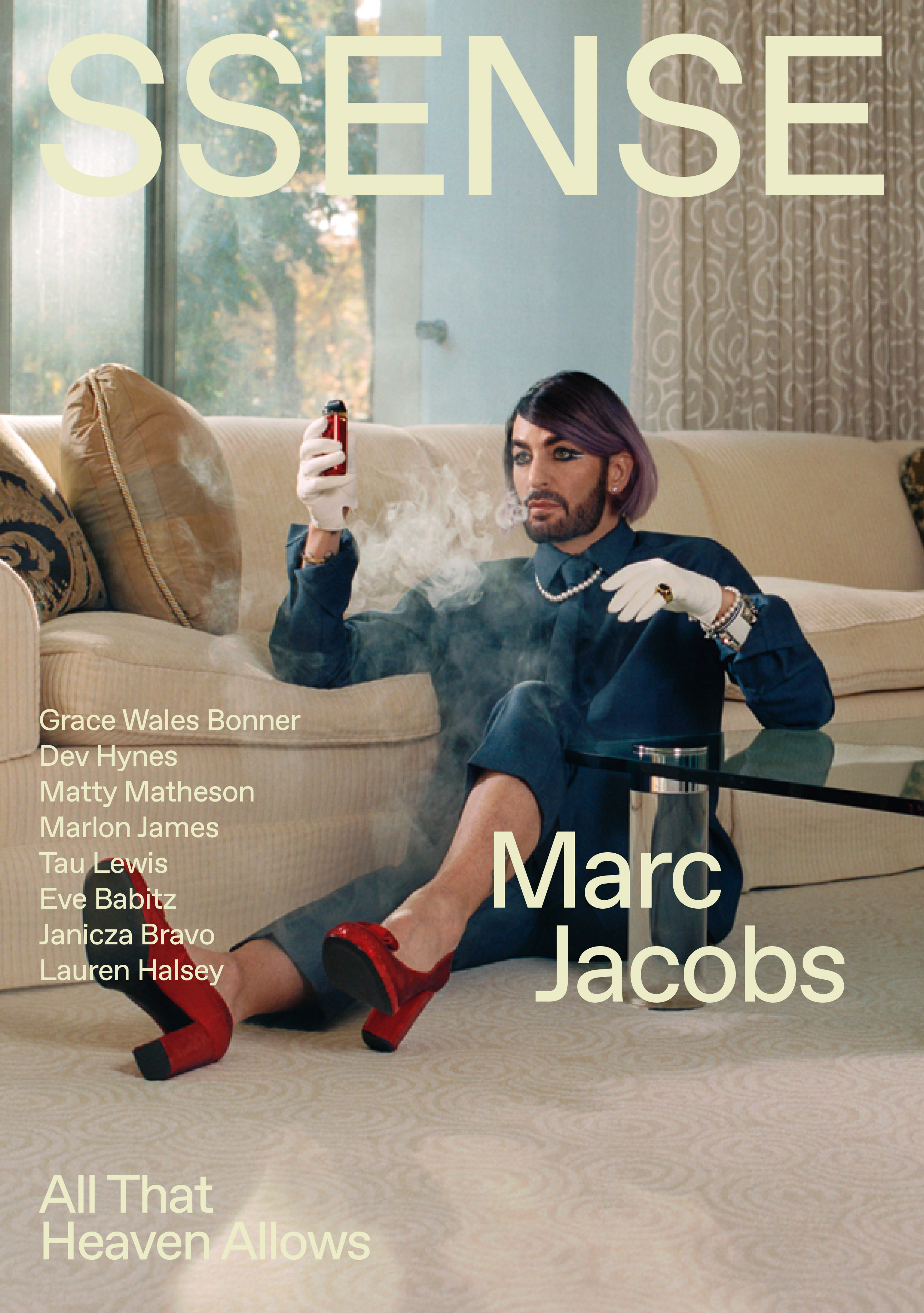
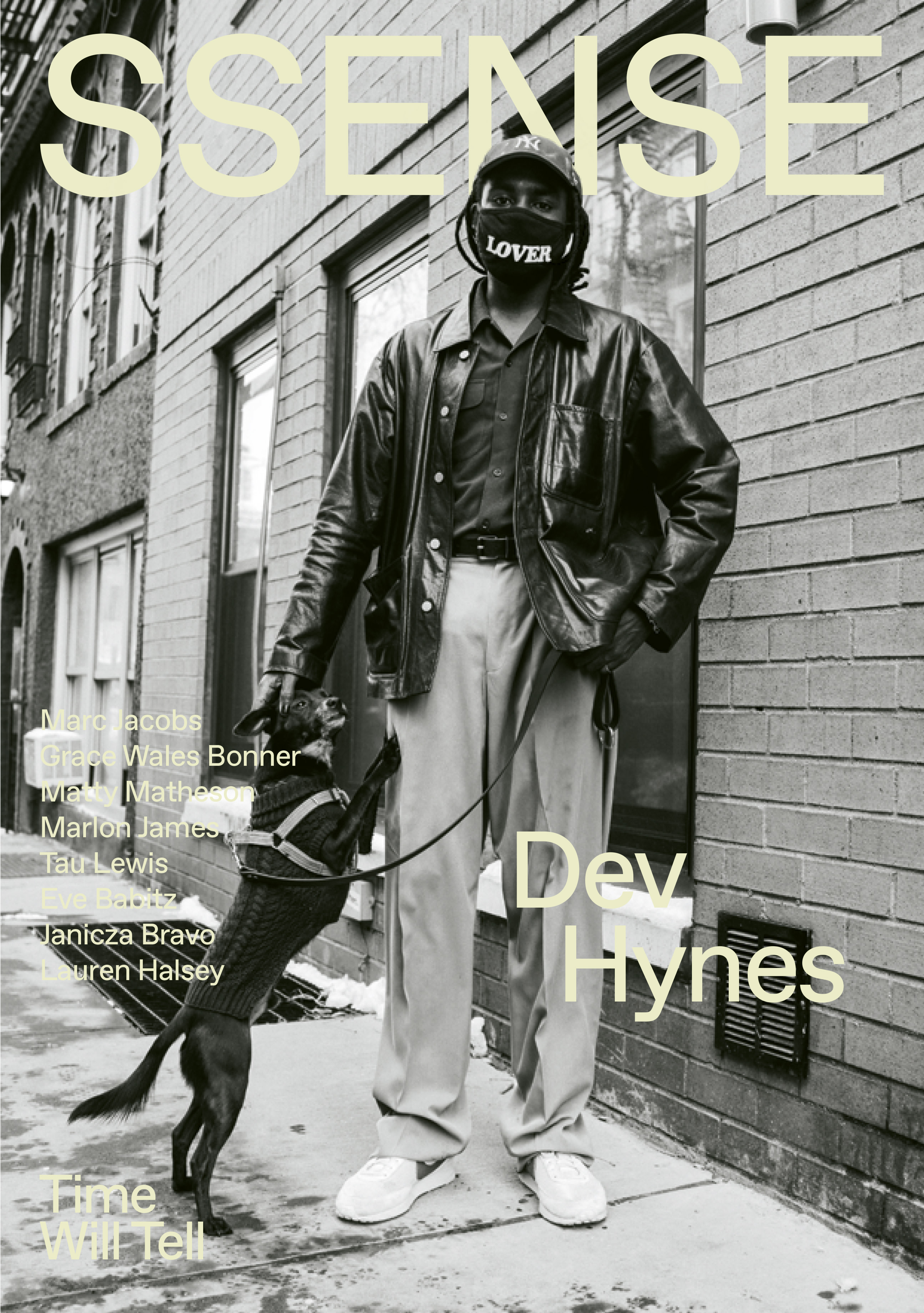
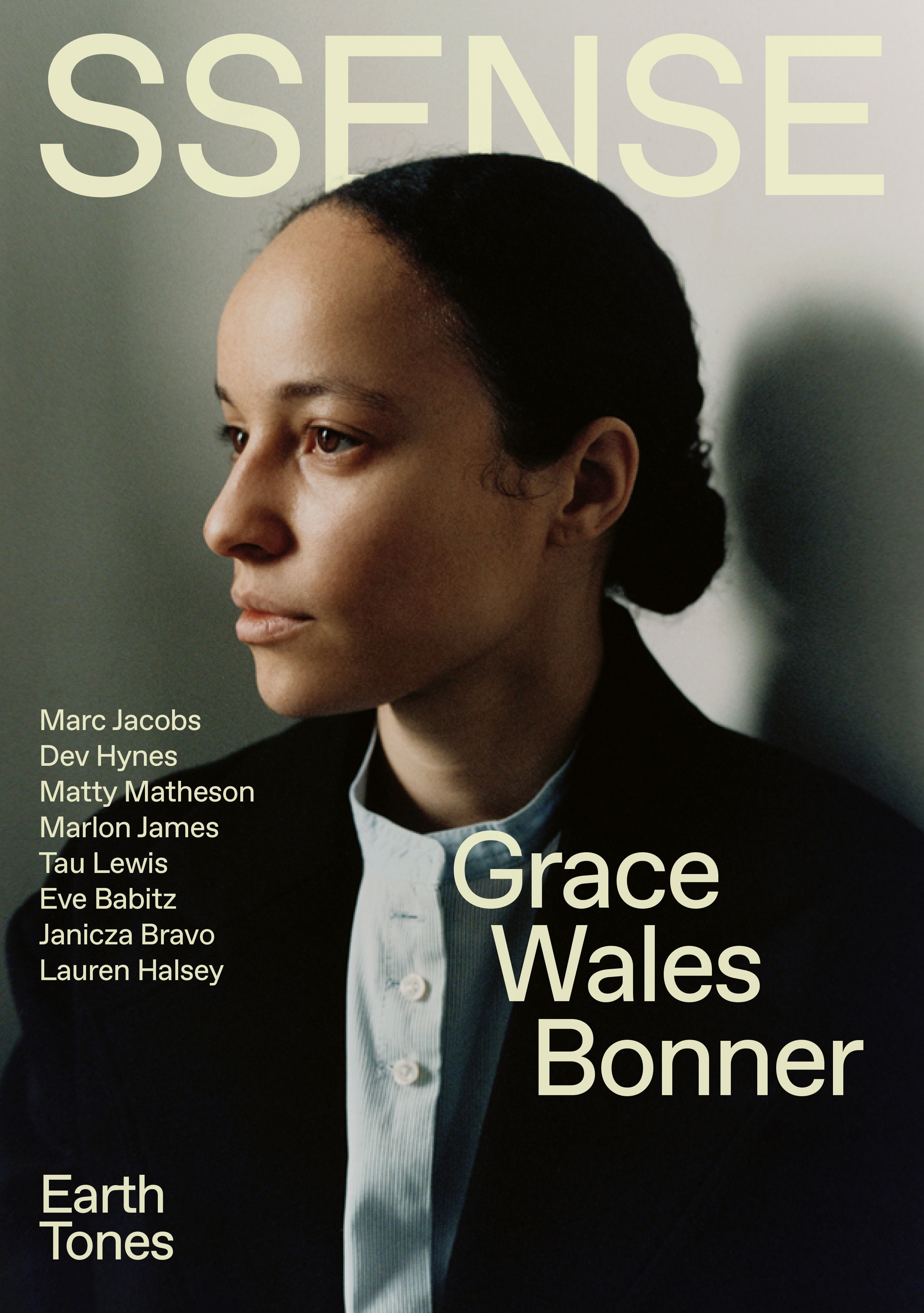
Editor's Letter
The legendary Los Angeles writer Eve Babitz—who answers a list of questions in these pages—was never one to overcomplicate material. She documented life as it was happening, with a no-sweat style that some described as “fizzy.” In other words, she sought pleasure. Her observations were casual, prepossessing, and magnetic.
Eve liaised with fame—born to and raised by a family adjacent to California royalty, she was a Hollywood local if there ever was one—but understood that its attainment wasn’t, as we say these days, sustainable. In Slow Days, Fast Company, she wrote that “the truly awful thing about success is that it’s held up all those years as the thing that would make every- thing all right. And the only thing that makes things even slightly bearable is a friend who knows what you’re talking about.”
A friend who knows what you’re talking about—especially in a year of inexorable grief—provides that rare steadying force and the quietly necessary element of well-being. This issue is about correspondence: the ways we’ve stayed in touch while keeping our distance. The group chat is something of a saving grace, but so is sending or receiving a postcard, or the coordinated efforts of eating and drinking, sharing recipes, and the dream of a future dinner party.
What matters most is not just the final version that you hold in your hands now, but also how it got to you. What’s the use of making anything if along the way we lose our focus, forget our aims, stop thinking about the future or too quickly mourn the past? In these words and images, we’ve collected essays, short fiction, poetry. We’ve speculated about the future of design, film, and art, and asked contributors to reimagine what fashion and clothing can mean; in our own way, we are trying to travel at the speed of a thought searching for some- one who knows what you mean.
Each of our covers represents a different perspective on this shared idea. As Thora Siemsen writes of Marc Jacobs, the visionary designer is ever-changing and forever curious, creating work with a commitment to a community of characters. In Marlon James’ conversation with Grace Wales Bonner, their shared references are generative—a dream dialogue between two artists whose projects remain nimble yet tethered to cultural histories. And in an ongo- ing conversation with Dev Hynes, the artist responds to change and companionship with a poetic interiority that is emblematic of his work.
Halfway through making this issue, we sent a list of questions to Eve Babitz and compiled her answers. How we got there was one kind of story; the story she tells in her replies is another. Simple, straightforward, and sent directly to you—we hope in turn you’ll share it with the friend who always knows what you’re talking about.
Durga Chew-Bose
Editor-In-Chief
Read Issue 4 Online
Shop Exclusive SS21 Magazine Apparel
Fall-Winter
2020
Featuring Jeremy O. Harris, Gaetano Pesce, Nan Goldin, Farah Al Qasimi, Andrew Kuo, Akeem Smith, Leilah Weinraub, Hilton Als, Nikil Saval, Emmanuel Olunkwa, Sara Cwynar
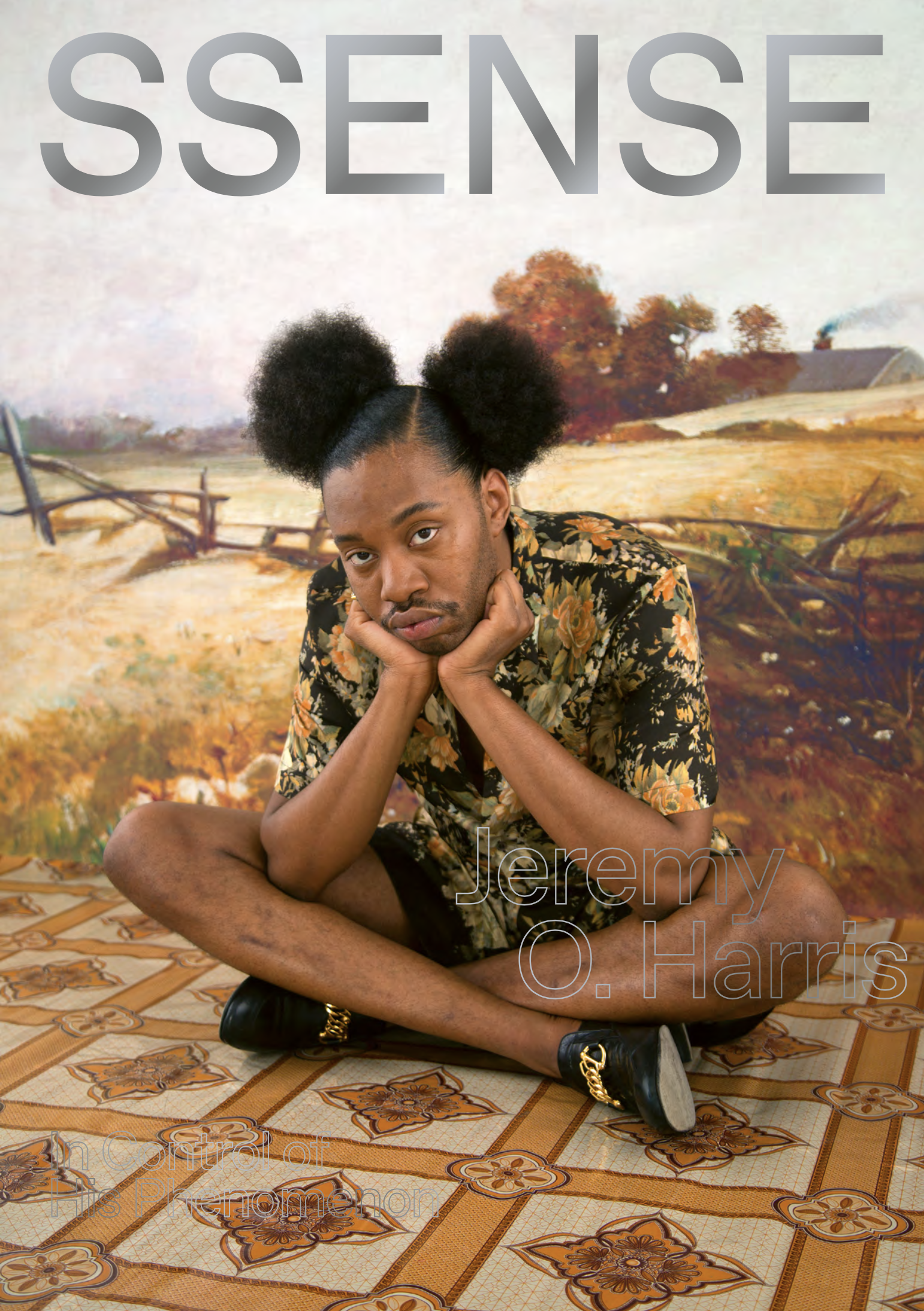


Editor's Letter
There is no bird’s-eye. No score or succinct way to capture just how heavily this year has pressed against us. A year marked by a global pandemic, and then a summer of grieving, anger, uprising. The extraordinary work of the Movement for Black Lives and Black Lives Matter emptied us from our homes in isolation and into the streets, to fight against white supremacy, anti-Black racism, anti-trans violence, and police brutality. True allyship requires a spectrum of work, of meeting this moment at every level: from local to global, from individual to structural.
And so, there is no recap—just more work to be done. Hindsight reveals history’s irreparable blind spots, and time and again, what is exposed in crisis is only exposed to those who were not paying attention. How will we carry these urgencies into the new year? These generative connections, the mutual aid, these meditations in an emergency? Art, we know, is congenital to unrest, and vision requires voices who are courageous— those propellent points of view that recast the way forward, long overdue.
For our third issue of the magazine, we decided to focus on just that, starting with our cover star: the playwright and polymath, Jeremy O. Harris, whose productions of Slave Play and Daddy have left his audiences and critics not merely enraptured, but hooked on how Harris makes it hard to watch—how he challenges whiteness, straightness, privilege, and the so-called immunity of goodwill. For any writer, much less one so early in his career, to receive this level of acclaim, is remarkable. As Doreen St. Félix writes— her conversation with Harris is winding, intimate, witty—“Harris has become, and maybe defined, for this new century, a category of cultural celebrity.” This is a sentiment St. Félix is not disapproving of, but rather, a sentiment that confirms Harris’ variegated and won- derfully recusant pursuits. Harris, St. Félix notes, is a muse who “remains in utter control of his phenomenon.” Who else can claim to have held the curtain for his critically acclaimed Broadway premiere, so as to ensure Rihanna had arrived? Who else seems to approach his projects with the same unlikely, brazen curation? Harris has brokered production and distribution deals with A24 and HBO, become a muse for Gucci and Bode, establishing himself as a star rising between the establishment and the vanguards. As Harris shares with St. Félix, “I do sometimes wish that I could have had a more graceful entrance into the world, but I also don’t know that I would've gotten the things out of my twenties that I wanted.” Harris’ sensitivities are grand, his seeking, accelerated. His style, aureate and always personal—and testified by Nigerian-British photographer Ruth Ossai, whose portraits of Harris for this issue lay hold of his contemplative regality, his sublime-easy in shorts, a skirt, lace and leather.
It’s for all these reasons (and more), that the inaugural SSENSE WORKS collection— set to launch this month—is proud to feature Harris’ design concept and vision. Inspired by the Black writers and artists who are a source of joy and of heritable agency like Zora Neale Hurston, Ethel Waters, painter Jacob Lawrence, and the photography of Carl Van Vechten, along with his friends and collaborators, like Janicza Bravo and Tyler Mitchell, the collection captures Harris’ rich, prismatic style, as well as the intimacy of his words: text from an unreleased work will be stitched throughout select garments. In essence, this collection is a further study of Harris’ approach to invention: building towards the future as a matter of paying tribute to and examining the past. These personal histories and where we come from speak to harmonies-yet-possible, and in Harris’ world, are not just essential, but romantic.
This issue furthers that thinking with contributions from Pulitzer Prize-winning writer, critic, and curator, Hilton Als, who shares a memory from a summer long ago, about the people we’ve left behind but love forever. There’s also a profile of Democratic socialist candidate running for Pennsylvania State Senate, Nikil Saval, whose roots in design have informed the collective power of his political platform. Beautiful fashion editorials for Bottega Veneta, Gucci, and emerging New York brand, Commission, capture our logic for deep interiority as it collides with reverie and our relationship to the outside, and a 1995 essay by Jamaica Kincaid, seizes Kincaid’s timeless clinic (and cleverness) at administering the necessary art of Becoming. Finally, a collection of letters, addressed to the future, from creative voices in our community who reflect on this particularly historic crossroads, where deliberating on what’s next is best described as a dead heat between hope and the unequaled, sometimes terrifying unknown.
Each page of this issue was created from the ground up, designed to be held in your hands and revisited as a document that is incomplete yet expectant in its purpose. The stories provide a view for looking backwards and forwards. And isn’t that the point? To pay attention, listen, and record as a means for future retrieval.
Durga Chew-Bose
Editor-In-Chief
Read Issue 3 Online
Spring-Summer
2020
Featuring Abella Danger, Alexis Sablone, Craig Green, HUA HSU, Keizo Shimizu + Daiki Suzuki, Kelis, Maia Ruth Lee, McKenzie Wark, Nico Hiraga, Pelle Cass, Petra Collins, Ryon Wu, Yasuo Yamamoto
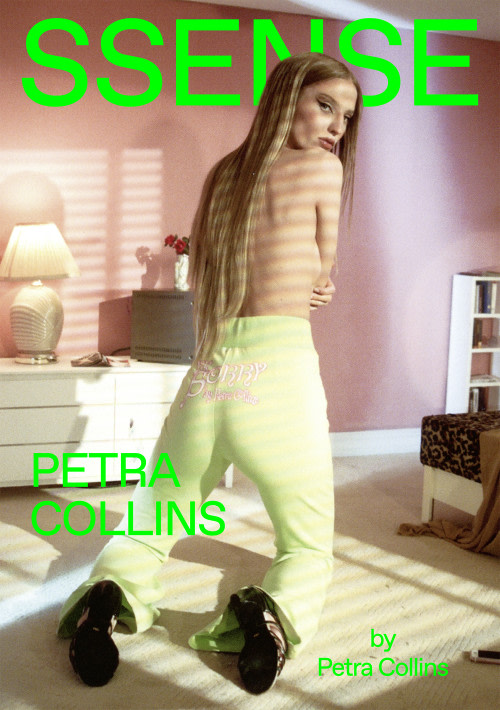
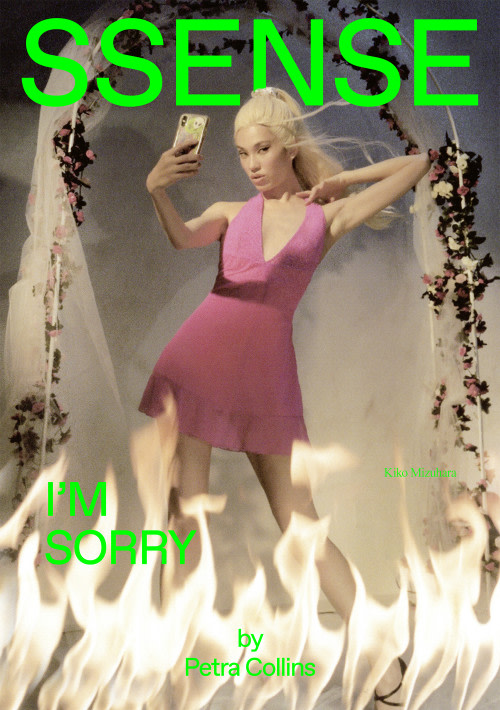
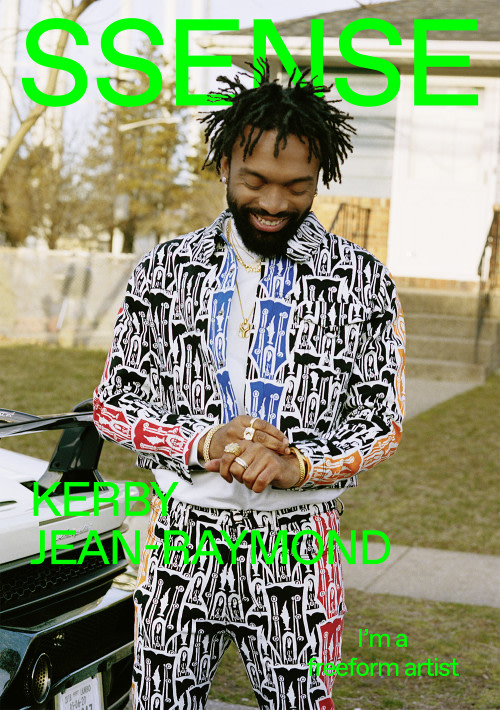
Editor's Letter
As this magazine goes to print, COVID-19 has disrupted the globe on an unprecedented scale. It is the first pandemic of the social media age, and its effects are no longer simply filtered by media outlets: we are witnessing the immeasurable impact on the lives of our peers and colleagues—and local individual and government responses, sometimes brilliant, sometimes disheartening—on every continent.
In the early 2000s, China accounted for only 4% of production in the world. It is now responsible for 20%. The supply chains and productions are so tightly integrated in all businesses worldwide that an outbreak in Wuhan spreads into markets and industry as quickly as the virus does from person to person. It’s a manifestation of how globally we operate today—and of how the center of power and trade has shifted to Asia. The weeks ahead will show us whether we can embrace how international we have truly become, working together to overcome. What is certain is that there is no way back, in our view, only a move towards a new understanding of community, collective action, responsibility, and how we share and work together. At SSENSE we embrace this energy in a magazine that depicts a collision of perspectives—historical and futurist, pop cultural and niche, slowed-down and hyper-accelerated—from both sides of the Pacific Ocean.
Our latest covers speak to this sentiment, and feature two SSENSE collaborators: Petra Collins and Kerby Jean-Raymond of Pyer Moss. Collins has designed her first capsule collection, to be released exclusively at ssense.com, and Jean-Raymond, an ongoing creative partner, puts his passion for cars on full display in our interview with Antwaun Sargent.
Joerg Koch
Editor-In-Chief
Read issue 2 online
Fall-Winter
2019
Featuring Big Sean, Jerry Lorenzo, Eli Russell Linnetz, Bernadette Corporation, Kelsey Lu, Kyary Pamyu Pamyu, Fraser Cooke, Kiko Mizuhara, Li-Ning
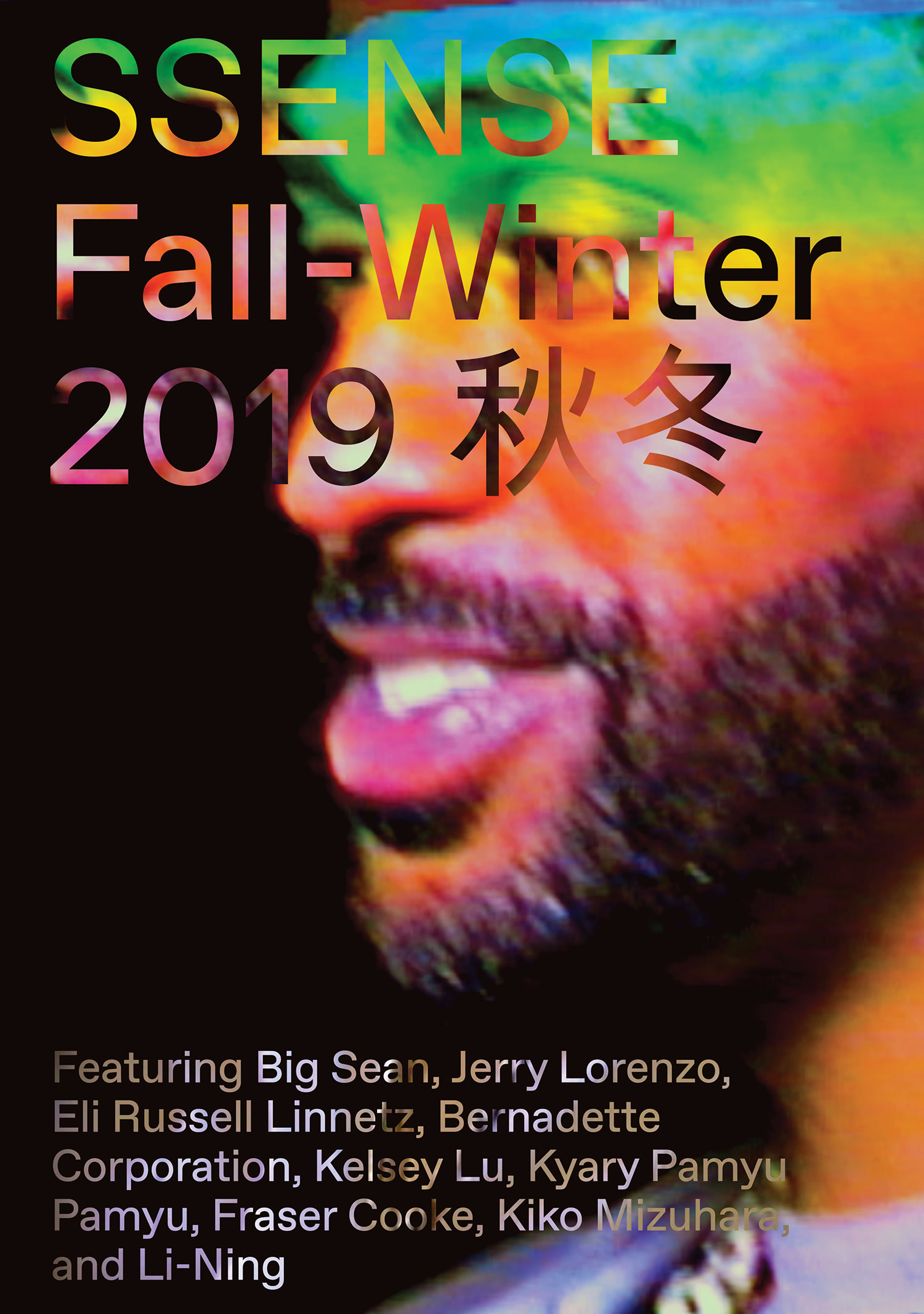
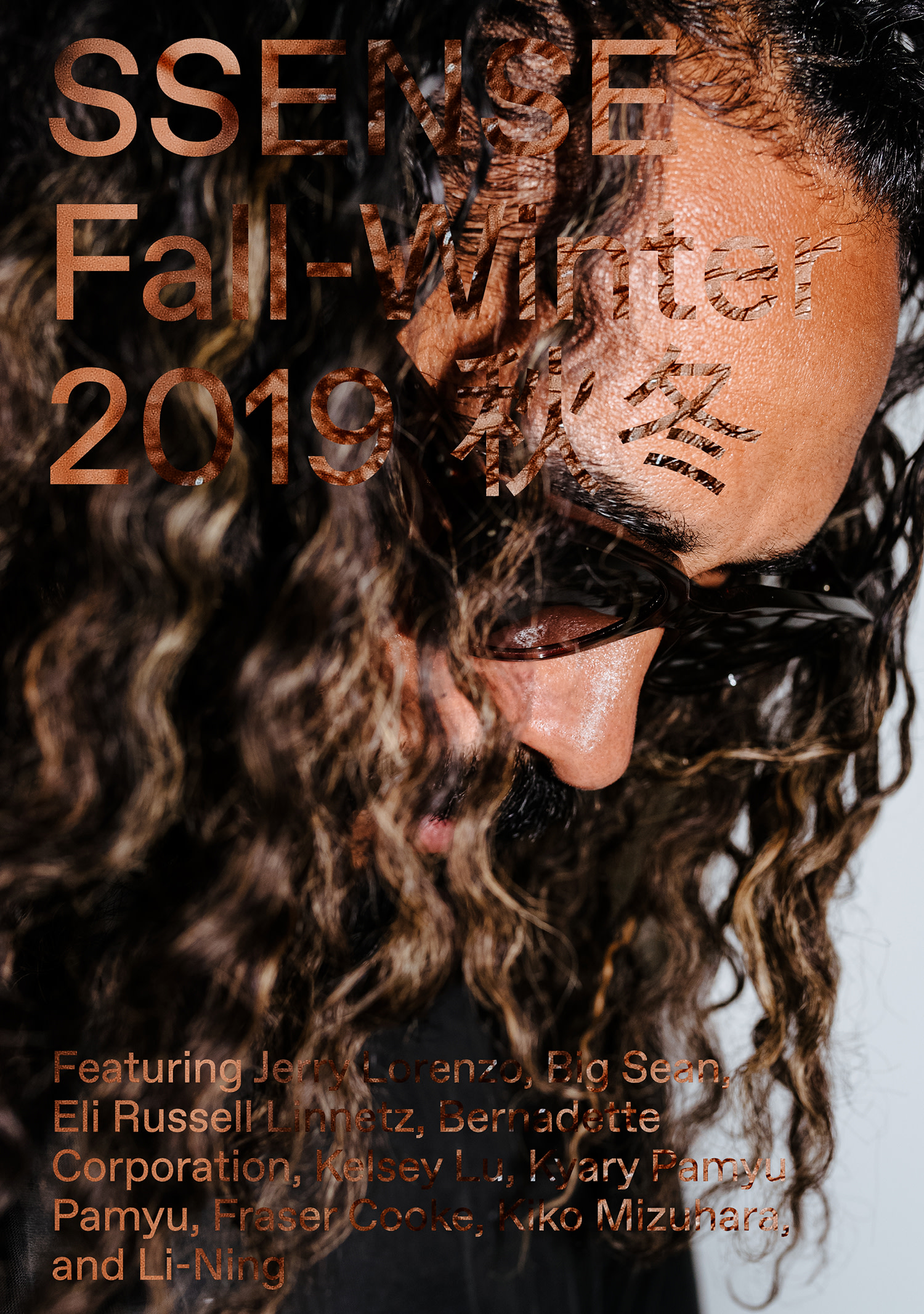
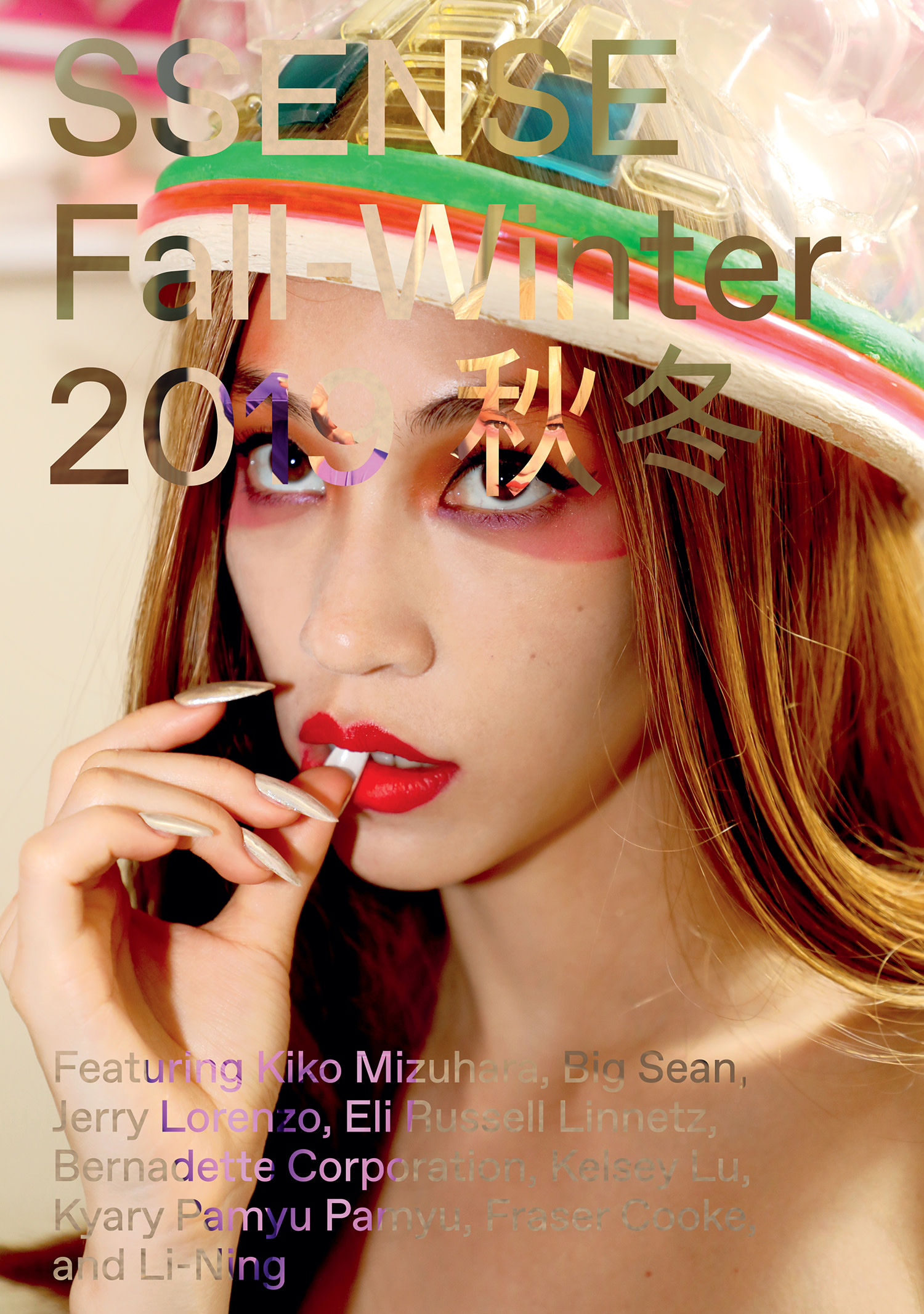
Editor's Letter
It is 2019, and China has overtaken the U.S. as the world's top fashion market. Last year, China already accounted for about a third of global spend in a luxury market estimated at 1.2 trillion euros overall. This is only the beginning. As the industry grows, it's predicted that by 2025, Chinese consumers will make up for 96% of the global market. It's clear Asia has emerged as a major engine, fuelled in large part by millennial and Gen Z consumers.
Meanwhile, across the Pacific, another motor of innovation has attracted the gaze of the luxury fashion industry: California, the world's fifth largest economy (and America's original exporter of both pop and subcultures). It’s also, of course, the source of those technologies that have transformed the way we communicate and do business—enabling, among other things, the evolving experience of digital commerce.
Now, we've all heard these statistics and abstract numbers before, gleefully repeated in presentations by sales teams. But when I'm traveling in Asia, what strikes me is people's sheer knowledge and enthusiasm when it comes to what's new. Whether it's in Shanghai, Seoul, or Tokyo, the conversations reveal an awareness and perspective about what's happening in Paris, Berlin, and New York that is deeper and more engaged than anything you hear in the old western capitals of fashion and culture. Unfortunately, this intense fervour is not mirrored evenly. Sales figures function as a marketing fantasy smokescreen, but cannot reflect real interest or dialogue.
The first issue of SSENSE responds to that need for reciprocity. An Asian-Pacific perspective is replacing the Atlantic one—an outdated view that went no further west than New York and no further east than Milan. This is a tectonic shift, rattling luxury and fashion but impacting much more than industry growth stats and consumer demographics. What will continue to change, regardless of trade wars or political power moves, is the flow of cultural production, revealing new and future forms of leadership and experimentation in both the business and the imagination of fashion and the creative fields.
This inaugural issue of SSENSE magazine celebrates the Pacific, and the conversations and futures that connect around it.
Joerg Koch
Editor-In-Chief
Read Issue 1 Online
